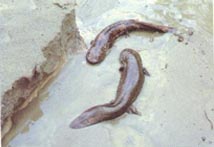Baishuijiang National Nature Reserve is located in Wenxian County, south of Gansu Province. The whole preservation zone is in the shape of a ribbon, with 110 kilometers long from the east to the west and 20 kilometers wide from the south to the north. Covering an area of 213,750 hectares, Baishuijiang National Nature Reserve features verdant and lush forest and a great variety of plants and animals. It was established in 1978 and mainly protects giant pandas, other rare wildlife and their ecosystem. In November 2000, Baishuijiang National Nature Reserve was formallyincludedin the International Man and Biosphere Reserve Network by the UNESCO.
 Climate
Climate
Baishuijiang National Nature Reserve is situated at the transitional zone between temperate zone and subtropical zone. It is moist and rainy in summer due to the influence of monsoon from the southeast, while it is in low temperature in winter because of Mongolian high pressure. It is 14.9℃on an average in temperature in arable areas. The lowest temperature is about 2.7℃, whichusually appears January, while the highest temperature is 23.1℃in July. The annual average precipitation is about 500-1,000 millimeters. There are around 260 frost-free days in a whole year.
 Physical Features
Physical Features
Baishuijiang National Nature Reserve is situated in the northeast part of the Minshan Mountain Range. Generally speaking, the precipitous terrain of Baishuijiang slopes from northwest to southeast, rising and falling abruptly. Its highest peak is 3,837 meters above sea level,while its average area is at the elevation of 2,500-3,100 meters.
 Plants
Plants
Baishuijiang National Nature Reserve is characterized by its great variety of plants, luxuriant forest and intact natural beauty. In the Reserve, there are 2,160 species of higher plants and 67 rare, precious and endangered species under the state protection, including dove tree, ginkgo, metasequoia, Taxus chinensis and masson pine.
The vegetation here can be vertically divided into five zones from the low elevation to high, namely evergreen broad-leaved mixed forests, deciduous broad-leaved forests, coniferous and broad-leaved mixed forests, coniferous forests and highland shrubbery or grassy marshland. The mild temperature, plenty rain, luxuriant forests and good ecological environment prove to be an ideal place for the growing of bamboo -- giant pandas' favorite food -- and consequently guarantee that giant pandas can live and multiply well here.
 Animals
Animals
 |
| giant salamanders |
In Baishuijiang National Nature Reserve, there are altogether 265 species of terrestrial vertebrate, 180 species of birds and over 2,000 species of reptiles. As a co1ourfu1 wildlife reserve, it is also one of the main habitats for China's giant pandas. In addition to pandas, there are other rare and precious animals such as black gibbons, takins, and golden eagles under the first-grade national protection. Animals in the Reserve under the second-grade state protection include macaques, otters, giant salamanders and gorals.
